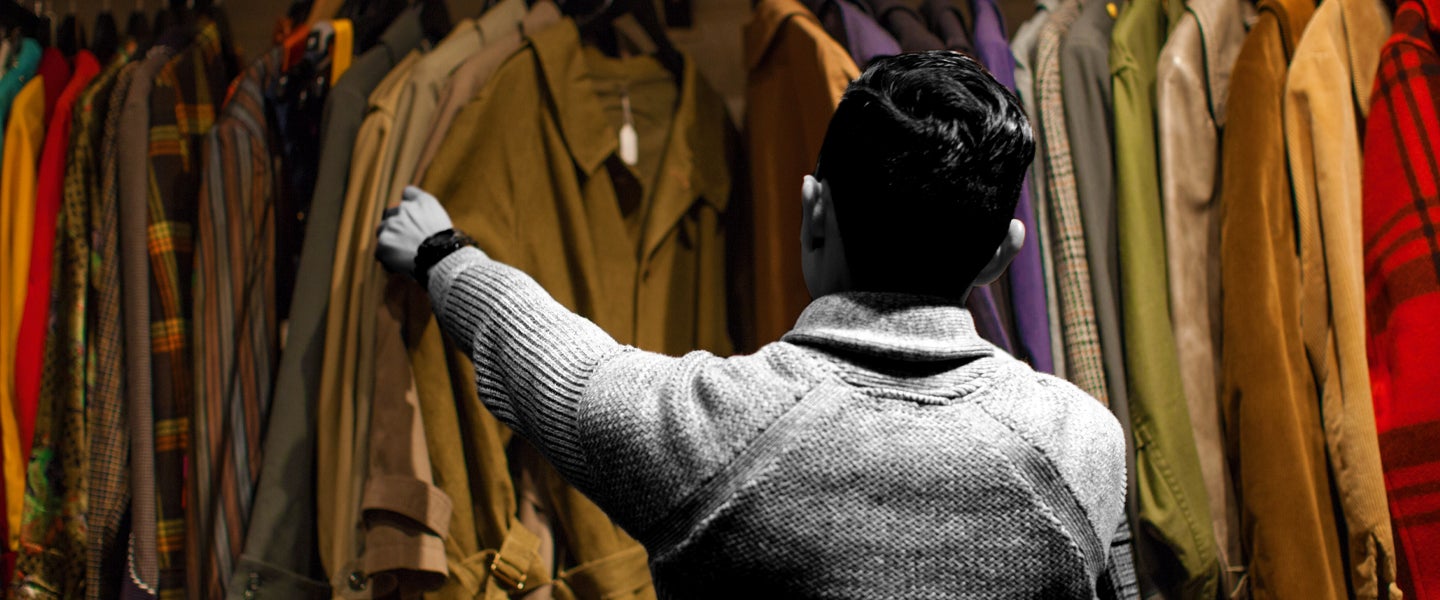Alec Leach, a former editor at Highsnobiety and founder of responsible fashion project Future Dust, loves his $21 suit. “Since I quit buying new clothes in April, I’ve bought five suits for a bit over $110,” says Leach, who lives in Berlin. “I just trawl eBay and Kleinanzeigen, which is kind of like a German Craigslist, to find stuff that’s good quality and at a decent price — I’m basically buying suits from Bavarian dads.” Leach says he has no trouble finding high-quality items, and that the process of scouring the internet for bargains is in itself satisfying, so long as you’ve got a good eye. “These are all good suits,” he continues. “You just need to know what you’re looking for.”
Since April, Leach has been participating in Extinction Rebellion’s fashion boycott, in which participants are encouraged not to buy new clothing for a year. “There is an abundance of clothing and textiles already in circulation which we can creatively repair, re-use, alter, upcycle, recycle and much more, minimizing our use of new resources,” reads the campaign page. “We encourage rebels to share through swapping or renting, or buying and selling second-hand.” Anyone who must buy new is encouraged to “carefully consider the most ethically and environmentally sound options — or to make their own.”
This is an approach to clothing that isn’t new to Frank, a 30-year-old art director in New York City, who has been avoiding new clothing for about six years. He cites concern for the environment combined with a frustration about the quality of fast-fashion items as his motivation for eschewing new items. “I was treating H&M tees like cashmere because they’d shrink if you looked at them wrong,” he explains. “Whereas with thrifting, you can find some staples and gems that will last another five years.”
As Leach suggests, there are real gems to be found. Frank’s best finds are a 1970s denim jacket that’s lasted him 10 years and a pair of Acne jeans, both of which cost him a mere $20. Charlie, a 35-year-old editor in the U.K. who also avoids new clothing for the sake of the planet, says his best find was an amazing old leather biker jacket with a mandala sewn into the back. “I love imagining who wore it before me,” he adds.
The fashion industry as it currently stands is an appalling consumer of resources. It’s responsible for eight percent of global climate impact, making it a worse offender than the airline industry, due in large part to its consumption of resources like water and oil during the production stage. “Cotton is a really intensive crop; it needs tons and tons of water to grow, and it only grows in areas where water is scarce,” Leach tells me. “Polyester and nylon are made from oil, and leather is also problematic because livestock farming puts loads of pressure on the planet, too.”
4 ways to make your wardrobe more sustainable – and work harder https://t.co/VVCD9GSkhD #Fashion #Sustainability pic.twitter.com/HwzSFGZqjA
— World Economic Forum (@wef) September 28, 2019
Thanks to the advent of fast fashion, in which trend items are churned out in compressed production cycles to masses of consumers at a low cost, clothing production doubled from 2000 to 2014, and the number of garments purchased annually by the average consumer increased by 60 percent. The typical consumer now views clothing as disposable, mends it less often and expects it to last for shorter periods than in the past: Consumers keep clothing items about half as long as they did 15 years ago, and some discard new items after just seven or eight wears.
Fortunately, this wasteful attitude to fashion seems to be abating, or is at least subject to sustained criticism. “Sustainability” is now fashion’s biggest buzzword, and while the word can be meaningless and prone to greenwashing, a growing cohort of activists, writers, consultants and fashion industry insiders are committed to genuinely meaningful alternatives, such as the pursuit of circular fashion and enthusiasm for recycling and upcycling.
But recycling is no silver bullet either. “It’s not easy making recycled clothing,” Leach explains. “It still uses up loads of energy and resources — most recycled materials need to be blended with new materials anyway, as they’re often not good enough quality to be used on their own.” Corey Boynton, who worked for three years as a project manager at a Seattle-based athleisure manufacturer, says it can be difficult for brands to access recycled textiles. “It was impossible to find a textile mill that made majority-recycled fiber content that felt like a high-quality material, and on the rare occasion that we did, the textile mills could never promise the volume that we’d need,” he explains. “My experience is that legitimately sustainable fashion is so costly that it’s difficult to base a business model on.”
Because of these contradictions, there’s a growing consensus that business won’t solve this problem, that the endless proliferation of so-called sustainable brands isn’t the answer, and that, as Leach is fond of saying on Future Dust, “we can’t buy our way out of the climate crisis.” Hence, the interest in second-hand clothing: The resale market is growing 21 times faster in the U.S. than other forms of fashion retail, and men like Leach are sick of the constant impetus to buy new things when there are so many worthwhile second-hand items available. “We have mountains and mountains of great clothes out there already,” Leach says, “so why not use them instead of making more stuff?”
This mindset shift, in which overconsumption is resisted and the aim is to extend the life of the clothing that already exists, isn’t so much a new trend as a return to an older attitude toward fashion. Tom, a 38-year-old cultural heritage worker in New Zealand, says he’s been boycotting fast fashion for about 10 years because of an upbringing in which his father encouraged him to have a thrifty, prudent approach to shopping and to buy “one great thing rather than five mediocre things.” He largely buys second-hand and tries to buy “things that won’t immediately date and which work in a number of situations,” something that’s “easy with menswear.”
Leach says sustainable fashion is “a very female space,” given the longstanding association of fashion with femininity and homosexuality. But the idea that fashion isn’t for straight men is eroding quickly, with an explosive growth in the menswear industry in recent years. Despite the traditional norm that it’s “unmasculine for a man to spend a great deal of effort on his outward appearance,” Charlie sees fashion as highly compatible with certain masculine ways of relating through knowledge. “The ultra-nerdy side of streetwear fits with our deep codes of ‘the masculine,’ with often laborious layering of details obscuring the simple joys of fashion,” he explains, describing this approach to men’s fashion, especially on spaces like Grailed, as being the little brother to collector culture.
The challenge, at least from the planet’s perspective, is how quickly this wave of male fashion enthusiasts can be convinced to resist overconsumption, buy second-hand and opt-out of fast fashion. Leach hopes that a mass movement in people willing to discover the joys of second-hand shopping — and shifting away from a status quo in which literal mountains of unwanted and sometimes brand new clothing fills landfills and recycling depots in developing countries — can play a role in mitigating the climate crisis. “Ultimately, we need serious intervention from big powerful people to solve this problem,” Leach says. “But consumer behavior can help push that.”
Even aside from the planetary benefits, though, these men say shopping second-hand makes them both look and feel better. “The fashion industry wants us to be buying new stuff non-stop, and people who buy new stuff non-stop tend to look like shit,” Leach tells me. “Going on a new-stuff detox is great: You really appreciate the stuff you have already, and you need to go on a bit of a voyage to find what you want.”
Leach adds that successful thrifting requires not only style, but the kind of personal qualities touted by the ancient philosophers. “It encourages patience and self-knowledge,” he says. “You need to actually know what you want, instead of the marketing director of a huge conglomerate-owned brand telling you what you want.”

